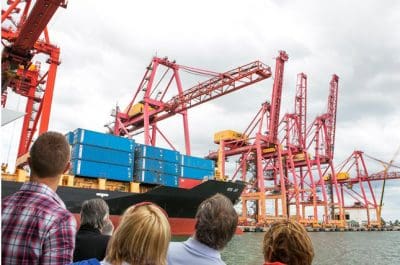LAST MONTH’S inaugural Grain Trade Australia Logistics Conference in Melbourne provided a good sounding board for a different perspective on the Australian grain industry.

Container terminals play a major part in Australian grain export. Photo: Port of Melbourne
Perhaps it was the fact the conference was about logistics and the future, and not about trade, markets and profitability now, that allowed for some levity and positivity to bubble over during the sessions and the networking that the gathering provided.
A diverse group of speakers tackled a range of issues from the significant investment in high-quality on-farm storage and logistics capacity designed to shorten the supply chain to capture greater control over sales and shipment timing and margins.
A major domestic customer talked about the importance of a tight supply chain that would reduce stock dwell times.
New export-terminal players espoused the significant lift in efficiency through design, and the employment of improved technology that was providing greater flexibility in areas including grain receivables and outloading.
Quality time was spent on continuing to educate all on matters surrounding Chain of Responsibility Laws from the farm to the point of export or consumption, especially given the significant evolution of road transport, and new and different road-freight configurations.
Equally, the growing importance of rail logistics was discussed, particularly the significant options and opportunities that will come from the Melbourne-to-Brisbane Inland Rail corridor as it becomes an east-coast logistical game-changer.
The conference even allowed some futuristic discussion around the disruption potential of blockchain technology.

Peter Wilson
My address to the gathering focused on just how important a flawless logistics chain was to successful contract execution, and the building of customer satisfaction in highly competitive markets.
Australia enjoys significant land-and-sea supply-chain brevity when compared with many of our competitors.
Our first-world components can have us position grain into the export path within just a few days and we can land containers into our nearest customers in just over two weeks, and to almost all our major customers in around four weeks.
However, for the most part, the Australian grains industry does not enjoy cost leadership. We have lots of underutilised assets right around Australia. Much of these assets are legacy investments which have been found wanting over this past couple of years as liquidity has dried up due to either smaller crops (drought) or prices being unattractive (global competition).
All of which has reduced the speed and volume of product being made available to export. Real oversupply (FSU production) or technical oversupply (tariffs, bans, financial and geopolitical instability) has stripped “traditional” origin exporters of margin and turn.
We need to accept that we are being disrupted mightily by fast- moving shifts in supply from non-traditional origins. Even customers are surprised at the supply depth at speed coming from “these
new entrants.”
Australian land prices, weighted for reliability, are very expensive, and with no sign of abatement, it’s impacting our production costs relative to key strong and seemingly reliable competitors.
Sure, we can be confident that some customers will pay a premium to play in Aussie grains, pulses and oilseeds. This is mainly due to the fact that if we have the product, we have a fantastically
reliable supply chain; we ship the right product, on time every time within a robust food-safety envelope that gives customers confidence in the product itself, and the knowledge that we as
exporters service what we sell.
Sadly, not all customers have any interest in such service; they are satisfied that others can meet their needs in terms of physical quality and execution at a much lower price.
So where to from here?
We must hunt out the best customers and markets and keep them through flawless service, execution and product quality. We need to collaborate more throughout the supply chain, particularly as it condenses out of necessity.
When was the last time a grain trader spoke with a plant breeder or the person that manages a supermarket’s meat section?
We need to identify all inefficiencies in our chains and remove them ruthlessly. We need to seek out our domestic customers and industry and gain a greater understanding of their needs and serve
them better.
Maybe the grains industry should aim to ensure more grain is exported as premium beef, lamb and dairy products than raw material.
How do we use blockchain technology to slice costs and reduce payment and execution risks and costs?
Are we prepared for the coming of Inland Rail that will make the movement of raw materials and finished products along an efficient east coast rail spine?
One gets to think of many things when one is driving a farm truck that has no radio, air-conditioning or need for a speedo!



HAVE YOUR SAY